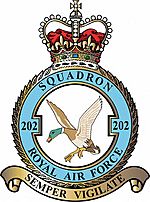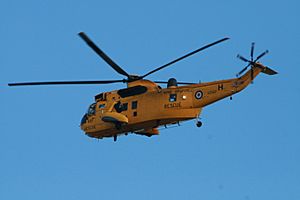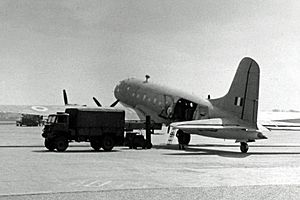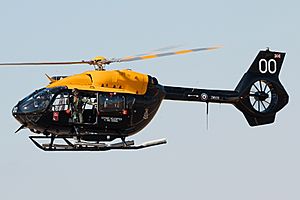No. 202 Squadron RAF facts for kids
Quick facts for kids No. 202 Squadron RAF |
|
|---|---|

Squadron badge
|
|
| Active |
|
| Country | |
| Branch | |
| Type | Flying squadron |
| Role | Search and rescue training |
| Part of | Defence Helicopter Flying School |
| Home station | RAF Valley |
| Motto(s) | Semper vigilate (Latin for 'Be Always Vigilant') |
| Aircraft | Airbus Helicopters Jupiter HT.1 |
| Commanders | |
| Current commander |
Squadron Leader Simon Allen |
| Insignia | |
| Squadron badge heraldry | A mallard alighting. Approved by King George VI in March 1937. |
| Squadron codes | JU (Allocated Apr 1939 – Sep 1939, no evidence of use) TQ (Sep 1939 – Aug 1943) AX (May 1941 – Aug 1943) TJ (Jul 1944 – Jun 1945) Y3 (Oct 1946 – Apr 1951) A (Apr 1951 – 1956) |
No. 202 Squadron is a special part of the Royal Air Force (RAF). It trains pilots to fly helicopters for sea and mountain rescue missions. The squadron is part of the No.1 Flying Training School. They currently use the Airbus Helicopters H145 Jupiter aircraft.
Before this, the squadron was famous for its search and rescue work. They used Sea King HAR3 helicopters. These missions took place from three bases in the northern part of the United Kingdom. The squadron first started as one of the very first aeroplane squadrons of the Royal Naval Air Service (RNAS). Later, it became part of the RAF.
Contents
History of the Squadron
Early Days and World War I
No. 202 Squadron officially started on April 1, 1918. This happened when the Royal Naval Air Service (RNAS) changed its No. 2 Squadron into No. 202 Squadron. This was part of forming the new Royal Air Force (RAF). The original No. 2 Squadron RNAS began on October 17, 1914.
During the First World War, the squadron served on the Western Front. They flew reconnaissance (scouting) and bombing missions. Their bases were in Belgium and France. The squadron stopped operating on January 22, 1920.
Between the World Wars
The squadron was brought back for a short time from April 9, 1920, to May 16, 1921. During this period, it worked closely with navy ships.
In 1929, the squadron was reformed again. This happened when No. 481 Flight, based in Malta, became No. 202 Squadron. They flew Fairey III floatplanes, which are planes that can land on water. Throughout the 1930s, they continued to fly patrols over the Mediterranean Sea. In 1935, they received new Supermarine Scapa flying boats.
World War II Missions
During the Second World War, the squadron flew missions to hunt submarines. These missions took place from RAF Gibraltar. They used Saro London, Consolidated Catalina, and Short Sunderland flying boats. They also used Fairey Swordfish torpedo bombers.
In 1944, the squadron moved its Catalinas to RAF Castle Archdale in Northern Ireland. The squadron stopped operating there on June 12, 1945.
After the Wars
Flying for Weather Reports
No. 202 Squadron was reformed on October 1, 1946. This happened when No. 518 Squadron changed its name. It became a squadron that flew for weather reports. They were based at RAF Aldergrove near Belfast.
They used Handley Page Halifax GR.6 & A.9 bombers. These planes were changed to fly long missions over the North Atlantic to study the weather. These missions were called "Bismuth." From November 1950, they started using the more modern Handley Page Hastings Met.1. They continued this weather reporting role until July 31, 1964, when the squadron stopped operating.
Search and Rescue Heroes
On September 1, 1964, the squadron was reformed again. This time, it was for a new role: helicopter search and rescue. This happened when No. 228 Squadron changed its name. They were based at RAF Leconfield in Yorkshire.
They started using the Westland Whirlwind HAR.10 helicopter. Parts of the squadron were based at RAF Acklington, RAF Ouston, RAF Coltishall, and RAF Leuchars. In September 1976, the squadron headquarters moved to RAF Finningley. Its flights were at RAF Boulmer, RAF Leconfield, RAF Coltishall, RAF Lossiemouth, and RAF Brawdy.
From July 1978, the squadron started using the Westland Sea King HAR3. However, they used the Westland Wessex HAR2 for a short time. This was while their Sea Kings were busy during the Falklands War in 1982. When Finningley closed in 1989, the squadron moved its main base to Boulmer. Later, in April 2008, it moved to RAF Valley in Anglesey.
The main job of RAF search and rescue was to save military pilots who had crashed. But in peacetime, their aircraft were also used for civilian emergencies. More than 95% of the rescues done by the squadron were for civilians. These rescues included helping people from planes, fishing boats, ferries, oil rigs, and those stuck in mountains or on cliffs. They also rescued people from the waters around the UK.

In 2006, the government decided to let a private company run the search and rescue helicopter service in the UK. A ten-year contract was signed in March 2013 with Bristow Helicopters. They would run the service from 2015 using new AgustaWestland AW189 and Sikorsky S-92 helicopters. The RAF's helicopter rescue operations stopped in stages from March to September 2015. 'A' Flight at Boulmer stopped flying in October 2015. 'B' Flight at RAF Leconfield stopped in March 2015. 'D' Flight at Lossiemouth stopped in April 2015.
Starting Up Again
In May 2016, the Search and Rescue Training Unit (SARTU) was renamed 202 Squadron. It became the part of the Defence Helicopter Flying School that trains pilots for sea and mountain rescues. They were based at RAF Valley and used the Bell Griffin HT1 helicopter.
After a short break in January 2018, No. 202 Squadron was reformed again in March 2018. It continued its role as the 'maritime and mountains' training squadron for the DHFS. They were then equipped with the Airbus Jupiter HT1.
Aircraft Operated
No. 202 Squadron has flown many different types of aircraft throughout its history. Here are some of them:
- Royal Aircraft Factory B.E.2
- Avro 504
- Bristol Scout
- Nieuport 17
- Sopwith Pup
- Sopwith 1½ Strutter
- Farman F.40
- Short 184
- Airco DH.4
- Airco DH.9
- Fairey IIID
- Fairey IIIF
- Supermarine Scapa
- Saro London
- Consolidated Catalina
- Fairey Swordfish
- Short Sunderland
- Handley Page Halifax
- Handley Page Hastings
- Westland Whirlwind
- Westland Sea King
- Westland Wessex
- Bell Griffin HT1
- AgustaWestland AW139
- Airbus Jupiter HT1
Battle Honours
Battle honours are special awards given to military units for their bravery and success in battles. No. 202 Squadron has received the following battle honours. The ones marked with an asterisk (*) can be shown on the squadron's official flag, called a standard.
- Western Front (1916–1918)*
- Atlantic (1939–1945)*
- Mediterranean (1940–1943)*
- North Africa (1942–1943)
- Biscay (1942–1943)*
See also
- RAF Search and Rescue Force
- 22 Squadron – the other RAF Sea King SAR squadron in the UK
- 771 Naval Air Squadron & HMS Gannet SAR Flight – the Royal Navy's similar units
- 1564 Flight – a Sea King SAR unit in the Falkland Islands
- Rescue – a 1990 TV show about the squadron's search and rescue work




